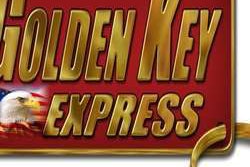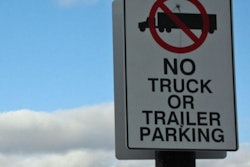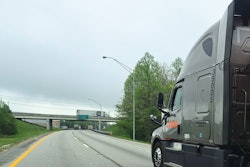Tim and Margaret Brochu of Sanford, Maine, prefer percentage pay over mileage pay, “especially if it’s high dollar freight,” Tim says.
No owner-operator would pooh-pooh an extra $10,000 every year, especially if it could be obtained relatively easily. Here are 10 simple ways by which owner-operators can gain $1,000 – some by boosting revenue, others by cutting costs. Of course, not all these strategies are available to every individual. But read on, and chances are you’ll find a few ways to help yourself.
- DRIVE FOR PERCENTAGE OF REVENUE.
“You make a lot more money with percentage pay, especially if it’s high-dollar freight,” says former owner-operator Tim Brochu of Sanford, Maine.Overdrive research bears him out. The average income for percentage operators is about $2,000 higher than the average for per-mile pay, and most high-earning owner-operators are paid this way.
That doesn’t mean, of course, that every percentage deal is superior to every per-mile deal. As with any other form of compensation, carefully check the fine print and do comparative math before changing carriers. What freight is involved, for example, can make a big difference.
Now a company driver for a six-truck fleet at Glenwood Farm in New Hampshire, Brochu gets 25 percent of the load “no matter what, even if that rate goes up,” he says.
When the rate increases, so does the percentage driver’s pay. If the rate is $5,000, Brochu’s cut is $1,250. When the load’s oversized, requires a crane, has multiple stops, or is delayed a day because a receiver isn’t ready, and if each factor adds $1,000 to the rate, then it’s $9,000, and Brochu’s cut is $2,250.
“If you’re making mileage pay, no matter how difficult the load is, how much it pays or how long you’re delayed with it, you always make the same,” Brochu says.
Less-than-truckload freight also means a bonus for Brochu. “If we get an LTL load, the dispatcher spends all day on the computer looking for another load to fill the trailer,” Brochu says. “That adds to the rate and increases my pay.”
- MANAGE TIME MORE EFFICIENTLY.
In other words, spend more time driving – legally, of course. If you typically max out your on-duty hours but not your driving hours, try to rearrange your routine to get a little more time behind the wheel.At 46 cents a mile net income, an extra $1,000 for the year requires 2,175 additional miles. If you can drive 60 extra miles per week for 37 weeks, you’ll net that extra $1,000.
Finding that extra driving hour is easy. Avoid long waits in lines by refueling, truck washing and showering when business is slow. Plan short routes, but avoid obvious slowdowns. Start an hour early. Work an hour later. In truck stops, avoid video arcades and television lounges if your hours allow you to run. Save laundry, haircuts, bill-paying and similar tasks for home time.
- INCREASE INSURANCE DEDUCTIBLES.
The key here is to accept higher, but prudent risk by choosing a higher deductible to lower one or more insurance premiums.The exact savings depends on your state, truck, application and driving record, but saving $1,000 a year is achievable unless you already have high deductibles.
For example, “If he raises his deductible on his physical damage (fire, theft, collision) coverage from $1,000 to $2,500, his premiums will come down,” says truck insurance specialist Hector Sardina of Sardina Insurance in West Palm Beach, Fla.
Keep in mind that truck loan terms might cramp your options, Sardina says. “Sometimes the finance companies require certain deductibles,” he says.
If your total exposure with deductibles is increasingly high, discuss with your financial adviser how much to save in an emergency fund to ensure that a serious accident doesn’t put you out of business or plunge you into heavy debt.
- USE AN IN-CAB HEATER.
While a gen-set might cost $6,000 to $10,000 installed and require years to recoup the investment, it’s possible to regain the initial investment on an in-cab heater in one year – and to save $1,000 on top of that. This especially is true for someone running Northern states and spending many nights in the sleeper.“The Espar Airtronic D-2 costs about $1,400 installed,” says John Dennehy, Espar Heater Systems’ marketing vice president.
Assuming an idling truck burns a gallon of diesel per hour, idling six to eight hours a day costs $16.50 to $22 a day in fuel. An in-cab heater, using .07 gallon an hour, burns about $1.16 to $1.54 in six to eight hours. That’s $15.34 to $20.46 saved daily.
A $1,400 investment would be recouped in two or three months, and an additional $1,000 in about two months or less. If you’re exposed to strong winter weather November through March, that should be long enough to net the extra $1,000.
Should fuel average higher than $2.75, the payback time shortens. And these figures don’t reflect your long-term savings by reducing the engine wear caused by prolonged idling.
- EAT OUT LESS.
A good meal often is your only immediate reward after working, so you wouldn’t want to forego all restaurant meals. But you don’t have to go cold turkey to save $1,000.Restaurant meals cost about $10, and large fast-food meals can be almost that much. Compare that with the $15 cost of four Kaiser rolls, 12 ounces of premium cold cuts, four ounces of imported Swiss cheese, small bags of chips and jars of condiments, garnishes such as onions, lettuce and tomatoes, and four pieces of fresh fruit. Those supplies will make four tasty, healthy lunches.
If that or something comparable can substitute for eating out four lunches or suppers per week, you’ve saved $25 a week. After one year, congratulate yourself on saving $1,300, and maybe notch up the belt a couple clicks.
Short-term truck parking is easy and legal at most grocery stores, and also at rest areas and picnic spots that offer refreshing breaks from driving.
- KEEP TIRES PROPERLY INFLATED.
Improperly inflated tires are expensive in several ways, including wasted fuel and shorter tire life. The biggest chunk of change may come from downtime and the road service call for tire failure that proper inflation would have prevented.“The owner-operator will not only save fuel – up to 5 percent – equally importantly, his tires are going to last a heck of a lot longer, and they’ll be retreadable,” says Harvey Brodsky, managing director of the Tire Retread Information Bureau.
According to ATBS, owner-operators who are careless about inflation can save an average 3 percent of fuel costs by keeping tires properly inflated. But it takes only a 2 percent decrease in fuel consumption to save $1,000 at the 91,000-mile mark.
That’s not all. According to Michelin, 20 percent under-inflation – 80 psi instead of 100 psi, for example – causes 10 percent to 33 percent tread loss. That translates to 45,000 to 85,000 fewer miles per tire.
Other than the discipline to check pressure often, all you need is a quality air pressure gauge. A sturdy, calibrated gauge costs about $25 in most truck stops.
“Don’t check the tires by hitting them with a stick or kicking them,” Brodsky advises. “Use a tire gauge, and it should be properly calibrated. Any reputable tire dealer has a master gauge to check it against.”
- QUIT SMOKING.
Assume $28 a carton and a pack-a-day habit. If you quit on Jan. 1 and throw that $28 in a box every 10 days, you can give yourself a $1,000 gift at Christmas.However, there can be costs associated with quitting. Smokers often find they need substitutes, such as chewing gum or snacks, and many people need over-the-counter or prescription medications.
On the other hand, as with proper tire inflation, the benefits from breaking a smoking habit go far beyond the immediate cash savings: better circulation, respiration, teeth, breath, stamina and overall health; and no tobacco smell or burn holes in clothes, rugs and furniture.
- REDUCE/REGULATE SPEED.
Dropping one mile per hour at highway speeds improves fuel efficiency by one-tenth mile per gallon. And that’s all you need to save $1,000 in one year.Assume 100,000 highway miles a year. That’s 20,000 gallons, costing $55,000.
Reducing your average speed by one mile an hour increases mileage from 5 to 5.1 mpg. Now the truck uses just 19,608 gallons to travel 100,000 miles. That’s a 392-gallon savings, which translates to $1,078.
Here’s the sweet part: Your cost is zero, and slowing down also cuts pollution and wear on all moving parts.
- INSTALL AN OIL BYPASS FILTER.
Oil bypass filter manufacturers say their products either eliminate oil changes or radically increase drain intervals. A typical standard for most applications is one oil change annually.The filters assist, but don’t replace, factory filters and have proved themselves in long-term studies of large and small fleets using oil bypass filtration systems in various applications. Most factory filters remove particles down to 15 microns in size. Bypass filter manufacturers say the devices remove particles smaller than 5 microns and moisture, too. As well, bypass filters increase engine life and don’t void warranties.
Requirements include a reliable oil analysis and a qualified technician’s advice about petroleum-based and synthetic oils.
Costs and performance vary between filter systems, but here’s an example: At $150 each, oil changes every 15,000 miles cost $1,200 yearly. Compare that $1,200 with the first year’s cost of using a bypass filter: $150 for one oil change and $250 for the filtration system, yielding an $800 difference.
Add in some long-term savings on improved engine longevity, and you’ve got your $1,000. In subsequent years – with no cost to install the bypass system – oil changes alone will save more than $1,000.
- USE ONBOARD SCALES.
You can save money in more than one way with onboard scales, which convert air pressure in truck and trailer suspensions into increasingly accurate, on-the-ground weight. For heavy haulers, onboard scales are a must-have.The savings vary widely because of several factors: how frequently you use scales, how far you drive to reach them, and whether the time devoted to those trips cuts into your driving hours or only your on-duty, non-driving hours.
Say twice weekly scale-outs take an hour each. Assuming 60 miles an hour average speed, that’s 120 miles not driven per week. At 46 cents a mile net income, that’s $55.20 lost per week, or $2,870 a year. Also, assume a five-mile round trip to scale out. That’s 10 miles weekly, or $5.50 for fuel. Add $16 a week for two scale-out fees, and that’s $21.50 a week, or $1,118 a year. Add the $2,870 and it’s almost $4,000. Onboard scales parts and installation cost $1,000 to $1,600, so even on the high end, you have a system paid for and $2,400 to boot after a year.
And the peace of mind from avoiding overweight hassles: priceless.







